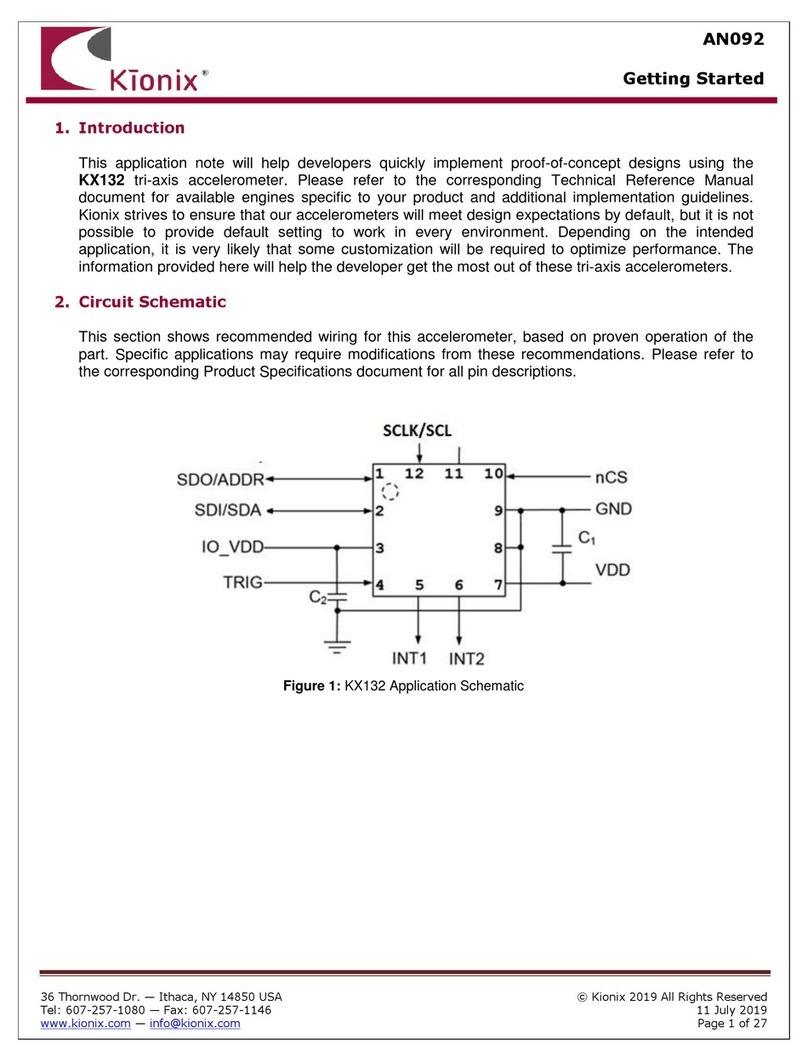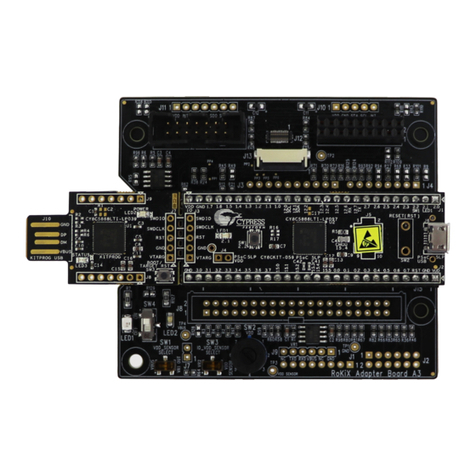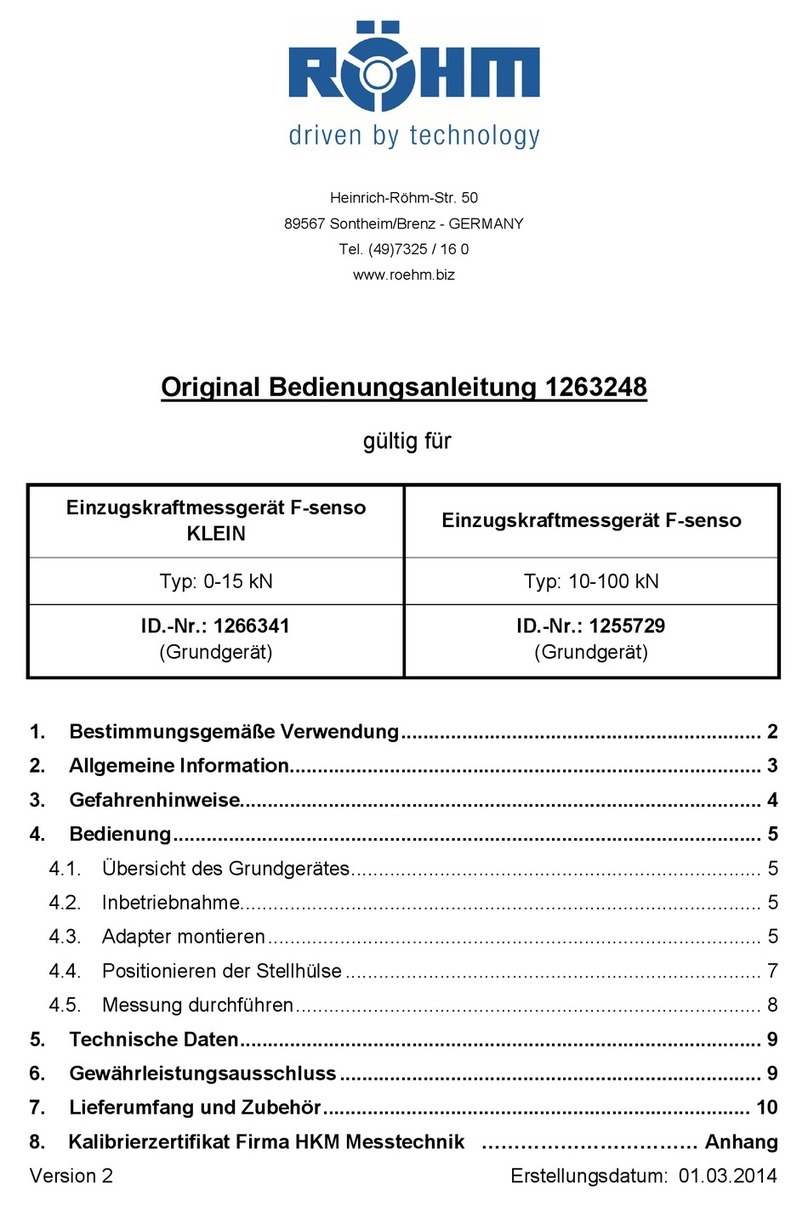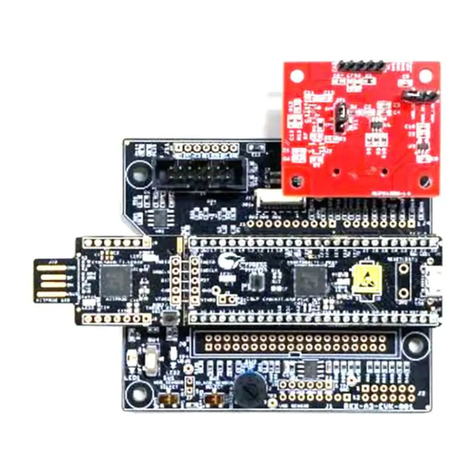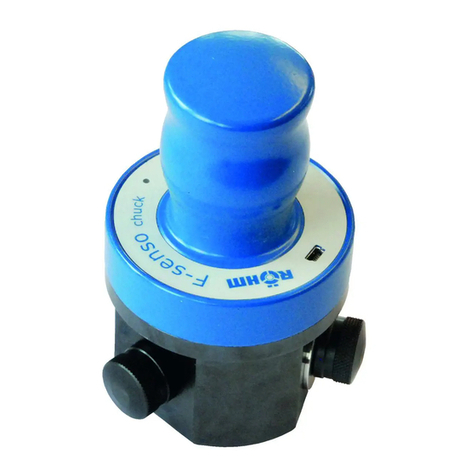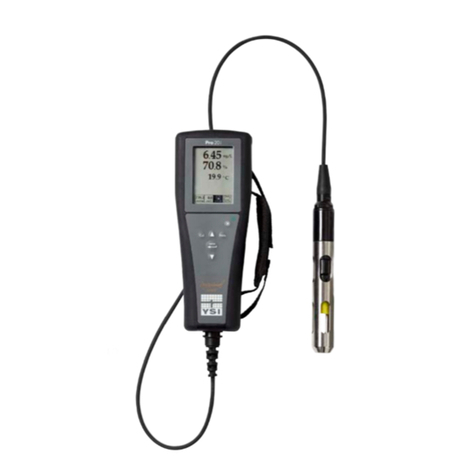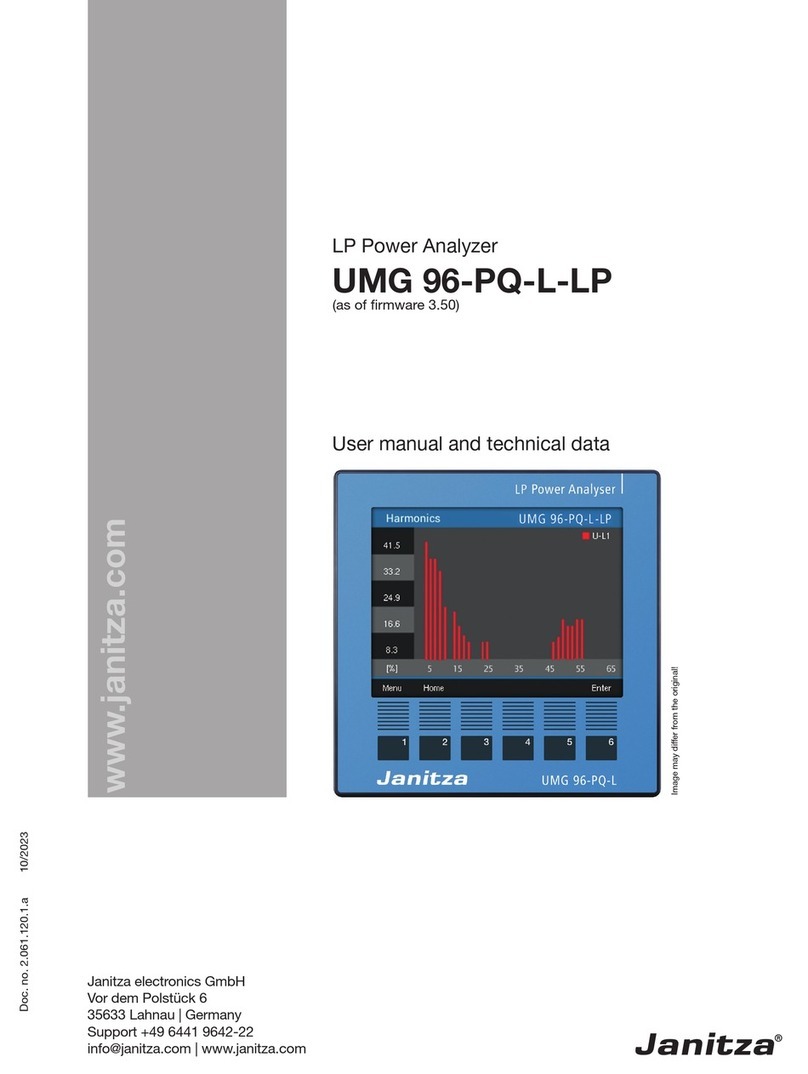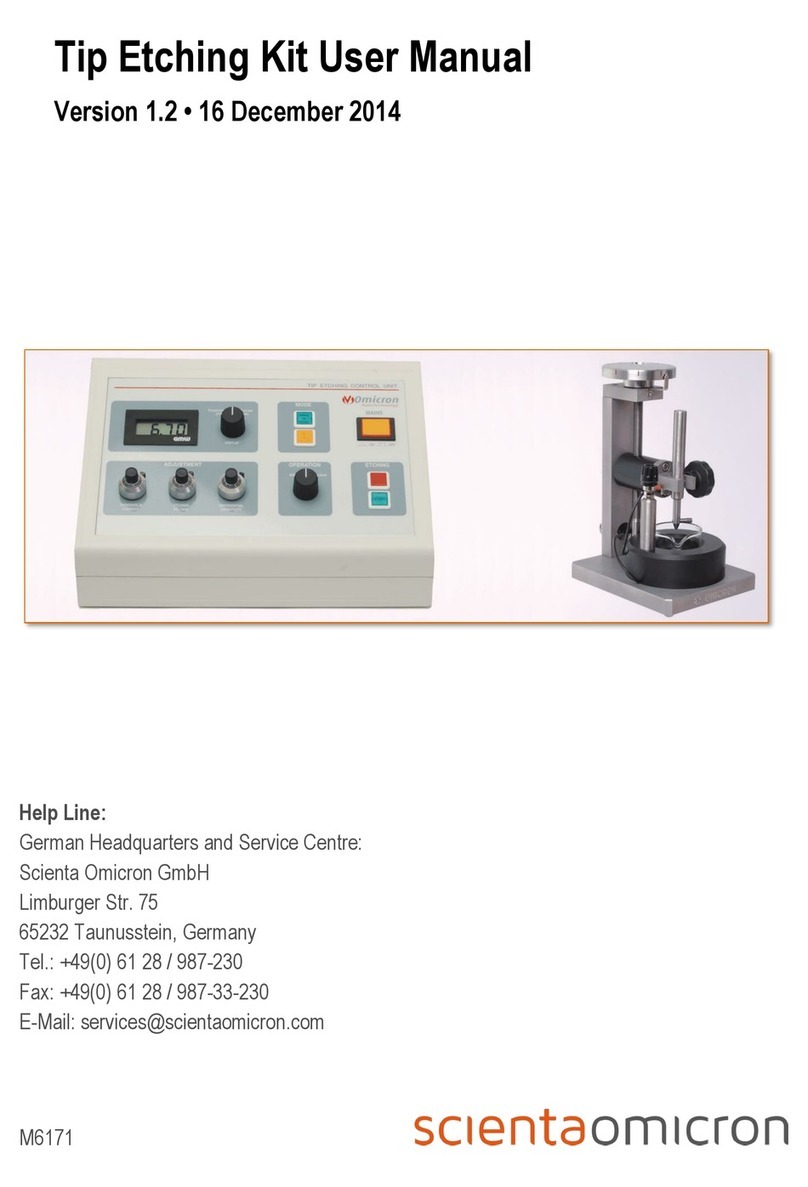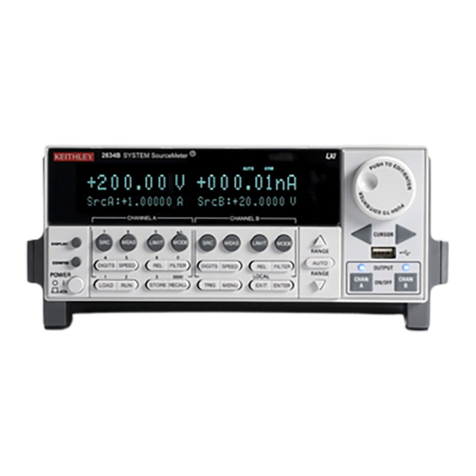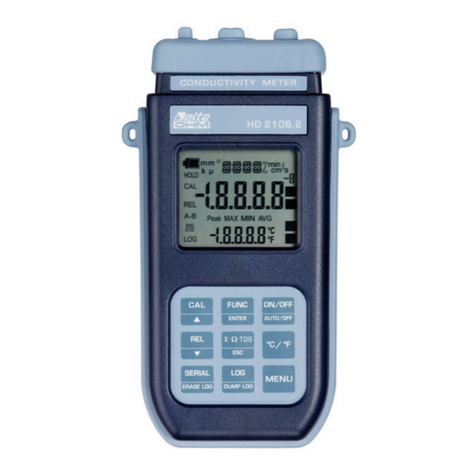Rohm Kionix KX134 User manual

AN101
Getting Started
36 Thornwood Dr. —Ithaca, NY 14850 USA
Tel: 607-257-1080 —Fax: 607-257-1146
© Kionix 2019 All Rights Reserved
11 July 2019
Page 1 of 27
1. Introduction
This application note will help developers quickly implement proof-of-concept designs using the
KX134 tri-axis accelerometer. Please refer to the corresponding Technical Reference Manual
document for available engines specific to your product and additional implementation guidelines.
Kionix strives to ensure that our accelerometers will meet design expectations by default, but it is not
possible to provide default setting to work in every environment. Depending on the intended
application, it is very likely that some customization will be required to optimize performance. The
information provided here will help the developer get the most out of these tri-axis accelerometers.
2. Circuit Schematic
This section shows recommended wiring for this accelerometer, based on proven operation of the
part. Specific applications may require modifications from these recommendations. Please refer to
the corresponding Product Specifications document for all pin descriptions.
Figure 1: KX134 Application Schematic

AN101
© Kionix 2019 All Rights Reserved
11 July 2019
Page 2 of 27
3. Quick Start Implementations
Here we present several basic ways to initialize the part. These can vary based on desired operation,
but generally the initial operations a developer wants to do are: 1) read back acceleration data
asynchronously, 2) read back acceleration data when next data is ready via interrupt (synchronous
data reading), 3) use of the sample buffer, 4) use the Wake-Up function, 5) activate the tilt position
function, 6) activate the tap/double-tap function, and 7) activate the free-fall function. These cursory
solutions are provided as a means for configuring the part to a known operational state. Note that
these conditions just provide a starting point, and the values may vary as developers refine their
application requirements.
3.1. Asynchronous Reading
This example configures and enables the accelerometer to start outputting sensor data that
can be asynchronously read from the output registers.
-Write 0x00 to Control 1 (CNTL1) to set the accelerometer in stand-by mode
Register Name
Address
Value
CNTL1
0x1B
0x00
-Write 0x06 to Output Data Control (ODCNTL) to set the Output Data Rate (ODR) of the
accelerometer to 50 Hz. This step is optional as this is also a default setting.
Register Name
Address
Value
ODCNTL
0x21
0x06
-Write 0xC0 to Control 1 (CNTL1) to set the accelerometer into operating mode (PC1=1), full
power mode (RES=1), data ready disabled (DRDYE=0), range to ±8g (GSEL=0).
Register Name
Address
Value
CNTL1
0x1B
0xC0
-Acceleration data can now be read from the XOUT_L, XOUT_H, YOUT_L, YOUT_H,
ZOUT_L, and ZOUT_H registers in 2’s complement format asynchronously. To reduce the
duplicate sensor data, wait at least 1/ODR period before reading the next sample.

AN101
© Kionix 2019 All Rights Reserved
11 July 2019
Page 3 of 27
3.2. Synchronous Reading (with hardware interrupt)
This example configures and enables the accelerometer to start outputting sensor data with a
synchronous signal (DRDY) and data can read from the output registers.
-Write 0x00 to Control 1 (CNTL1) to set the accelerometer in stand-by mode
Register Name
Address
Value
CNTL1
0x1B
0x00
-Write 0x30 to Interrupt Control 1 (INC1) to enable physical interrupt pin INT1, set the polarity
of the physical interrupt to active high and configure for latched operation (Note: if the output
registers are read in a burst sequence, the latched interrupt will auto clear by default).
Register Name
Address
Value
INC1
0x22
0x30
-Write 0x10 to Interrupt Control 4 (INC4) to set the Data Ready interrupt to be reported on
physical interrupt pin INT1.
Register Name
Address
Value
INC4
0x25
0x10
-Write 0x06 to Output Data Control (ODCNTL) to set the Output Data Rate (ODR) of the
accelerometer to 50 Hz. This step is optional as this is also a default setting.
Register Name
Address
Value
ODCNTL
0x21
0x06
-Write 0xE0 to Control 1 (CNTL1) to set the accelerometer into operating mode (PC1=1), full
power mode (RES=1), data ready enabled (DRDYE=1), range to ±8g (GSEL=0).
Register Name
Address
Value
CNTL1
0x1B
0xE0
-Acceleration data can now be read from the XOUT_L, XOUT_H, YOUT_L, YOUT_H,
ZOUT_L, and ZOUT_H registers in 2’s complement format synchronously following the rising
edge of INT1.

AN101
© Kionix 2019 All Rights Reserved
11 July 2019
Page 4 of 27
3.3. Synchronous Reading (without hardware interrupt)
This example configures and enables the accelerometer to start outputting sensor data with a
synchronous signal (DRDY) and data can read from the output registers.
-Write 0x00 to Control 1 (CNTL1) to set the accelerometer in stand-by mode
Register Name
Address
Value
CNTL1
0x1B
0x00
-Write 0x06 to Output Data Control (ODCNTL) to set the Output Data Rate (ODR) of the
accelerometer to 50 Hz. This step is optional as this is also a default setting.
Register Name
Address
Value
ODCNTL
0x21
0x06
-Write 0xE0 to Control 1 (CNTL1) to set the accelerometer into operating mode (PC1=1), full
power mode (RES=1), data ready enabled (DRDYE=1), range to ±8g (GSEL=0).
Register Name
Address
Value
CNTL1
0x1B
0xE0
-Acceleration data can now be read from the XOUT_L, XOUT_H, YOUT_L, YOUT_H,
ZOUT_L, and ZOUT_H registers in 2’s complement format synchronously when the DRDY bit
is set (0x10) in the Interrupt Status 2 Register (INS2).
Register Name
Address
Value
INS2
0x17
ins2
if (ins2 & 0x10)
{
// read output registers
}

AN101
© Kionix 2019 All Rights Reserved
11 July 2019
Page 5 of 27
3.4. Sample Buffer Operation
3.4.1. Buffer Full Interrupt (BFI)
This example configures enables the accelerometer to start outputting sensor data to the
internal buffer until full. When the buffer is full, a hardware interrupt is generated and data can
then be read from the buffer. The mode of operation is first in, first out (FIFO) below.
-Write 0x00 to Control 1 (CNTL1) to set the accelerometer in stand-by mode
Register Name
Address
Value
CNTL1
0x1B
0x00
-Write 0x06 to Output Data Control (ODCNTL) to set the Output Data Rate (ODR) of the
accelerometer to 50 Hz. This step is optional as this is also a default setting.
Register Name
Address
Value
ODCNTL
0x21
0x06
-Write 0x30 to Interrupt Control (INC1) to enable physical interrupt pin INT1, set the polarity of
the physical interrupt to active high and configure for latched operation.
Register Name
Address
Value
INC1
0x22
0x30
-Write 0x40 to Interrupt Control 4 (INC4) to set the Buffer Full interrupt to be reported on
physical interrupt pin INT1.
Register Name
Address
Value
INC4
0x25
0x40
-Write 0xE0 to Buffer Control 2 (BUF_CNTL2) to enable the sample buffer (BUFE=1), to set
the resolution of the acceleration data samples collected to 16-bit resolution (BRES=1), to
enable the buffer full interrupt (BFIE=1), and set the operating mode of the sample buffer to
FIFO (BM=0).
Register Name
Address
Value
BUF_CNTL2
0x5F
0xE0
-Write 0xE0 to Control 1 (CNTL1) to set the accelerometer into operating mode (PC1=1), full
power mode (RES=1), data ready enabled (DRDYE=1), range to ±8g (GSEL=0).
Register Name
Address
Value
CNTL1
0x1B
0xE0
-Once a Buffer-Full Interrupt is issued on INT1 pin, acceleration data can then be read from
the Buffer Read (BUF_READ) register at address 0x63 in 2’s complement format. Since the
resolution of the samples data was set to 16-bit, the data is recorded in the following order:
X_L, X_H, Y_L, Y_H, Z_L and Z_H with the oldest data point read first as the buffer is in FIFO
mode. The full buffer contains 516 bytes of data, which corresponds to 86 unique acceleration

AN101
© Kionix 2019 All Rights Reserved
11 July 2019
Page 6 of 27
data samples. (Note: With BRES=0 (8-bit resolution), in BUF_CNTL2, it is possible to collect
171 samples or 513 bytes of data).
3.4.2. Watermark Interrupt (WMI)
This example configures enables the accelerometer to start outputting sensor data to the
internal buffer until a watermark is reached. When the watermark is reached, a hardware
interrupt is generated and data can then be read from the buffer. The mode of operation is
first in, first out (FIFO) below.
-Write 0x00 to Control Register 1 (CNTL1) to set the accelerometer in stand-by mode
Register Name
Address
Value
CNTL1
0x1B
0x00
-Write 0x06 to Output Data Control (ODCNTL) to set the Output Data Rate (ODR) of the
accelerometer to 50 Hz. This step is optional as this is also a default setting.
Register Name
Address
Value
ODCNTL
0x21
0x06
-Write 0x30 to Interrupt Control (INC1) to enable physical interrupt pin INT1, set the polarity of
the physical interrupt to active high and configure for latched operation.
Register Name
Address
Value
INC1
0x22
0x30
-Write 0x20 to Interrupt Control 4 (INC4) to set the Watermark interrupt to be reported on
physical interrupt pin INT1.
Register Name
Address
Value
INC4
0x25
0x20
-Write 0x2B (43d) to set a watermark level to exactly half of the buffer.
Register Name
Address
Value
BUF_CTNL1
0x5E
0x2B
-Write 0xE0 to Buffer Control 2 (BUF_CNTL2) to enable the sample buffer (BUFE=1), to set
the resolution of the acceleration data samples collected to 16-bit resolution (BRES=1) and
set the operating mode of the sample buffer to FIFO (BM=0).
Register Name
Address
Value
BUF_CNTL2
0x5F
0xE0
-Write 0xE0 to Control 1 (CNTL1) to set the accelerometer into operating mode (PC1=1), full
power mode (RES=1), data ready enabled (DRDYE=1), range to ±8g (GSEL=0).
Register Name
Address
Value
CNTL1
0x1B
0xE0

AN101
© Kionix 2019 All Rights Reserved
11 July 2019
Page 7 of 27
-Once a Buffer-Full Interrupt is issued on INT1 pin, acceleration data can then be read from
the Buffer Read (BUF_READ) register at address 0x63 in 2’s complement format. The data is
recorded in the following order: X_L, X_H, Y_L, Y_H, Z_L and Z_H (16-bit mode) with the
oldest data point read first as the buffer is in FIFO mode. The full buffer contains 258 bytes of
data, which corresponds to 43 unique acceleration data samples.
3.4.3. Trigger Mode
This example configures enables the accelerometer to start filling sensor data to the internal
buffer. Prior to a trigger event, once the watermark setting is reached, old data will be
discarded and new data will be added. Following a trigger event, data will continue to fill until
the buffer is full. A hardware interrupt is generated when the buffer is full and data can then
be read from the buffer. The mode of operation is first in, first out (FIFO). The purpose of this
example is to show how data can be captured both before and after an event (external trigger,
tap, wakeup, freefall).
-Write 0x00 to Control 1 (CNTL1) to set the accelerometer in stand-by mode
Register Name
Address
Value
CNTL1
0x1B
0x00
-Write 0x06 to Output Data Control (ODCNTL) to set the Output Data Rate (ODR) of the
accelerometer to 50 Hz. This step is optional as this is also a default setting.
Register Name
Address
Value
ODCNTL
0x21
0x06
-Write 0x30 to Interrupt Control 1 (INC1) to enable physical interrupt pin INT1, set the polarity
of the physical interrupt to active high and configure for latched operation.
Register Name
Address
Value
INC1
0x22
0x30
-Write 0x40 to Interrupt Control 4 (INC4) to set the Buffer Full interrupt to be reported on
physical interrupt pin INT1.
Register Name
Address
Value
INC4
0x25
0x40
-Write 0x2B (43d) to BUF_CNTL1, which sets a watermark level to exactly half of the buffer.
Register Name
Address
Value
BUF_CNTL1
0x5E
0x2B
-Write 0xE2 to Buffer Control 2 (BUF_CNTL2) to enable the sample buffer (BUFE=1), to set
the resolution of the acceleration data samples collected to 16-bit resolution (BRES=1), to
enable the buffer full interrupt (BFIE=1), and set the operating mode of the sample buffer to
Trigger mode.

AN101
© Kionix 2019 All Rights Reserved
11 July 2019
Page 8 of 27
Register Name
Address
Value
BUF_CNTL2
0x5F
0xE2
-Write 0x3F to Interrupt Control 2 (INC2) to enable all positive and negative directions that can
cause a wakeup event.
Register Name
Address
Value
INC2
0x23
0x3F
-Write 0xAE to Control 3 (CNTL3) to set output data rate for the wakeup engine (OWUF) to
50Hz.
Register Name
Address
Value
CNTL3
0x1D
0xAE
-Write 0x60 to Control 4 (CNTL4) to set the counter mode to clear (C_MODE=0), threshold
mode to relative (TH_MODE=1), enable the wakeup function (WUFE=1), disable the back to
sleep function (BTSE=0), set pulse reject mode set to standard operation and set the output
data rate for the back to sleep engine to its default of 0.781Hz.
Register Name
Address
Value
CNTL4
0x1E
0x60
-Write 0x01 to Control 5 (CNTL5) to put the sensor into sleep mode (MAN_SLEEP=1).
Register Name
Address
Value
CNTL5
0x1F
0x01
-Write 0x05 to Wakeup Function Counter (WUFC) to set the time motion must be present for
0.1 second before a Wake-up interrupt is triggered. The following formula is used:
WUFC (counts) = Desired Delay Time (sec) x OWUF (Hz)
WUFC (counts) = 0.1 sec x 50 Hz = 5 counts
Register Name
Address
Value
WUFC
0x4D
0x05
-Write 0x80 to the Wakeup Function Threshold (WUFTH) and 0x00 to Back to Sleep Wakeup
Function Threshold (BTSWUFTH) to set the wakeup threshold to 0.5g.
WUFTH (counts) = Wake-Up Threshold (g) x 64 (counts/g)
WUFTH (counts) = 0.5g * 64 counts/g = 32 (0x20) counts
Register Name
Address
Value
WUFTH
0x49
0x20
BTSWUFTH
0x4A
0x00

AN101
© Kionix 2019 All Rights Reserved
11 July 2019
Page 9 of 27
-Write 0xE0 to Control 1 (CNTL1) to set the accelerometer into operating mode (PC1=1), full
power mode (RES=1), data ready enabled (DRDYE=1), range to ±8g (GSEL=0).
Register Name
Address
Value
CNTL1
0x1B
0xE0
-Provide some time for the buffer to fill to the configured threshold. Assuming the default ODR
was used, it should take approximately 0.86 seconds. After this time, trigger a wakeup event
by shaking the unit above the configured threshold and timing settings. Next, wait for the
Buffer-Full Interrupt. Once Buffer-Full Interrupt is issued on INT1 pin, acceleration data can
then be read from the Buffer Read (BUF_READ) register at address 0x63 in 2’s complement
format. Since the resolution of the samples data was set to 16-bit, both high and low bytes of
each sample were stored in the buffer, and recorded in the following order: X_L, X_H, Y_L,
Y_H, Z_L, Z_H with the oldest data point read first as it is a FIFO buffer. The full buffer
contains 516 bytes of data, which corresponds to 86 unique acceleration data samples. The
data set will include all the data prior to the trigger event, plus all the data after the event.
3.4.4. Buffer Reading Tips
a) The acceleration data can be read from a buffer using multiple-byte read as shown in the
Figure 2 below. The register auto-increment feature is disabled when data is read from the
Buffer Read register.
b) If data is read using single-byte read, it should be read in increments of 3 bytes in 8-bit
resolution mode and 6 bytes in 16-bit resolution mode.
c) It is very important to follow proper I2C Write-Read sequence as specified in the product
specifications. More specifically, the Master should avoid sending the Stop (P) bit at the
end of the I2C Write command, and should issue a Repeat Start bit (Sr) at the start of the
I2C Read command as show in the Figure 2. Failure of following this sequence may result
in reading the same value from the Read Buffer.
Term
Definition
S
Start Condition
Sr
Repeated Start Condition
SAD
Slave Address
W
Write Bit
R
Read Bit
ACK
Acknowledge
NACK
Not Acknowledge
RA
Register Address
Data
Transmitted/Received Data
P
Stop Condition
Figure 2: Proper I2C Sequence to Receive Data from the Slave

AN101
© Kionix 2019 All Rights Reserved
11 July 2019
Page 10 of 27
3.5. Wake-up / Back-to-Sleep Engine
3.5.1. Wake-up
This example configures and enables the accelerometer to detect wake-up events using an
external interrupt pin with Back-to-Sleep function disabled.
-Write 0x00 to Control 1 (CNTL1) to set the accelerometer in stand-by mode
Register Name
Address
Value
CNTL1
0x1B
0x00
-Write 0x06 to Output Data Control (ODCNTL) to set the Output Data Rate (ODR) of the
accelerometer to 50 Hz. This step is optional as this is also a default setting.
Register Name
Address
Value
ODCNTL
0x21
0x06
-Write 0x30 to Interrupt Control 1 (INC1) to enable physical interrupt pin INT1, set the polarity
of the physical interrupt to active high and configure for latched operation.
Register Name
Address
Value
INC1
0x22
0x30
-Write 0x02 to Interrupt Control 4 (INC4) to set the Wakeup Function Interrupt (WUFI1=1) to
be reported on physical interrupt pin INT1.
Register Name
Address
Value
INC4
0x25
0x02
-Write 0x3F to Interrupt Control 2 (INC2) to enable all positive and negative directions that can
cause a wakeup event.
Register Name
Address
Value
INC1
0x22
0x3F
-Write 0xAE to Control 3 (CNTL3) to set output data rate for the wakeup engine (OWUF) to
50Hz.
Register Name
Address
Value
CNTL3
0x1D
0xAE
-Write 0x60 to Control 4 (CNTL4) to set the counter mode to clear (C_MODE=0), threshold
mode to relative (TH_MODE=1), enable the wakeup function (WUFE=1), disable the back to
sleep function (BTSE=0), set pulse reject mode to standard operation and set the output data
rate for the back to sleep engine to its default of 0.781Hz.
Register Name
Address
Value
CNTL4
0x1E
0x60

AN101
© Kionix 2019 All Rights Reserved
11 July 2019
Page 11 of 27
-Write 0x01 to Control 5 (CNTL5) to for the sensor into sleep mode (MAN_SLEEP=1).
Register Name
Address
Value
CNTL5
0x1F
0x01
-Write 0x05 to Wakeup Function Counter (WUFC) to set the time motion must be present for
0.1 second before a Wake-up interrupt is triggered. The following formula is used:
WUFC (counts) = Desired Delay Time (sec) x OWUF (Hz)
WUFC (counts) = 0.1 sec x 50 Hz = 5 counts
Register Name
Address
Value
WUFC
0x4D
0x05
-Write 0x80 to the Wakeup Function Threshold (WUFTH) and 0x00 to Back to Sleep Wakeup
Function Threshold (BTSWUFTH) to set the wakeup threshold to 0.5g.
WUFTH (counts) = Wake-Up Threshold (g) x 64 (counts/g)
WUFTH (counts) = 0.5g * 64 counts/g = 32 (0x20) counts
Register Name
Address
Value
WUFTH
0x49
0x20
BTSWUFTH
0x4A
0x00
-Write 0xE0 to Control 1 (CNTL1) to set the accelerometer into operating mode (PC1=1), full
power mode (RES=1), data ready enabled (DRDYE=1), range to ±8g (GSEL=0).
Register Name
Address
Value
CNTL1
0x1B
0xE0
-Monitor the physical interrupt INT1 of the accelerometer, if the acceleration input profile
satisfies the criteria previously established for the 0.5g motion detect threshold level in both
positive and negative directions of the X, Y, Z axis for more than 0.1 second, then there
should be positive latched interrupt present. Also, the WUFS bit in Interrupt Status 3 (INS3)
will be set to indicate the wake-up interrupt has fired. INS3 also provides information
regarding which axis/axes caused the wakeup interrupt. Finally, WAKE bit in Status (STAT)
will also be set to indicate the sensor is in WAKE mode.
Register Name
Address
Value
INS3
0x18
ins3
if (ins3 & 0x80)
{
// handle wakeup event
}

AN101
© Kionix 2019 All Rights Reserved
11 July 2019
Page 12 of 27
-Read Interrupt Latch Release (INL_REL) to unlatch (clear) the output interrupt created by the
motion detection function and to clear the WUFS bit in the Interrupt Status 3 (INS3).
Register Name
Address
Value
INT_REL
0x1A
N/A
-Write 0x01 to Control 5 (CNTL5) to force sleep state (MAN_SLEEP=1). With Back-to-Sleep
engine disabled, this step is required in order to be able to detect additional wake-up interrupt.
Note, this also clears the WAKE bit in STATUS_REG register to indicate Back-to-Sleep state.
Register Name
Address
Value
CNTL5
0x1F
0x01

AN101
© Kionix 2019 All Rights Reserved
11 July 2019
Page 13 of 27
3.5.2. Wake-up and Back-to-Sleep
This example configures and enables the accelerometer to detect both wake-up and back-to-
sleep events using an external interrupt pin.
-Write 0x00 to Control 1 (CNTL1) to set the accelerometer in stand-by mode
Register Name
Address
Value
CNTL1
0x1B
0x00
-Write 0x06 to Output Data Control (ODCNTL) to set the Output Data Rate (ODR) of the
accelerometer to 50 Hz. This step is optional as this is also a default setting.
Register Name
Address
Value
ODCNTL
0x21
0x06
-Write 0x30 to Interrupt Control 1 (INC1) to enable physical interrupt pin INT1, set the polarity
of the physical interrupt to active high and configure for latched operation.
Register Name
Address
Value
INC1
0x22
0x30
-Write 0x0A to Interrupt Control 4 (INC4) to set the Back to Sleep Interrupt (BTSI=1) and
Wakeup Interrupt (WUFI1) to be reported on physical interrupt pin INT1.
Register Name
Address
Value
INC4
0x25
0x0A
-Write 0x3F to Interrupt Control 2 (INC2) to enable all positive and negative directions that can
cause a wakeup event.
Register Name
Address
Value
INC2
0x23
0x3F
-Write 0xAE to Control 3 (CNTL3) to set output data rate for the wakeup engine (OWUF) to
50Hz.
Register Name
Address
Value
CNTL3
0x1D
0xAE
-Write 0x76 to Control 4 (CNTL4) to set the counter mode to clear (C_MODE=0), threshold
mode to relative (TH_MODE=1), enable the wakeup function (WUFE=1), enable the back to
sleep function (BTSE=1), set pulse reject mode to standard operation and set the output data
rate for the back to sleep engine to 50Hz.
Register Name
Address
Value
CNTL4
0x1E
0x76

AN101
© Kionix 2019 All Rights Reserved
11 July 2019
Page 14 of 27
-Write 0x01 to Control 5 (CNTL5) to force sleep state (MAN_SLEEP=1). Note, this also clears
the WAKE bit in STAT register to indicate Back-to-Sleep state.
Register Name
Address
Value
CNTL5
0x1F
0x01
-Write 0x05 to Back-to-Sleep Counter (BTSC) to set the time motion must be absent for 0.1
second before a Back-to-Sleep interrupt is triggered. The following formula is used:
BTSC (counts) = Desired Delay Time (sec) x OBTS (Hz)
BTSC (counts) = 0.1 sec x 50 Hz = 5 counts
Register Name
Address
Value
BTSC
0x4C
0x05
-Write 0x05 to Wakeup Function Counter (WUFC) to set the time motion must be present for
0.1 second before a Wake-up interrupt is triggered. The following formula is used:
WUFC (counts) = Desired Delay Time (sec) x OWUF (Hz)
WUFC (counts) = 0.1 sec x 50 Hz = 5 counts
Register Name
Address
Value
WUFC
0x4D
0x05
-Write 0x80 to Wakeup Function Threshold (WUFTH) and 0x00 to Back to Sleep Wakeup
Function Threshold (BTSWUFTH) and 0x80 to Back to Sleep Threshold (BTSTH) to set the
wakeup and back to sleep thresholds to 0.5g.
WUFTH (counts) = Wake-Up Threshold (g) x 64 (counts/g)
WUFTH (counts) = 0.5g * 64 counts/g = 32 (0x20) counts
BTSTH (counts) = Back To Sleep Threshold (g) x 64 (counts/g)
BTSTH (counts) = 0.5g * 64 counts/g = 32 (0x20) counts
Register Name
Address
Value
WUFTH
0x49
0x20
BTSWUFTH
0x4A
0x00
BTSTH
0x4B
0x20
-Write 0xE0 to Control 1 (CNTL1) to set the accelerometer into operating mode (PC1=1), full
power mode (RES=1), data ready enabled (DRDYE=1), range to ±8g (GSEL=0).
Register Name
Address
Value
CNTL1
0x1B
0xE0

AN101
© Kionix 2019 All Rights Reserved
11 July 2019
Page 15 of 27
-Monitor the physical interrupt INT1 of the accelerometer, if the acceleration input profile
satisfies the criteria previously established for the 0.5g motion detect threshold level in both
positive and negative directions of the X, Y, Z axis for more than 0.1 second, then there
should be positive latched interrupt present. Also, the WUFS bit in Interrupt Status 3 (INS3)
will be set to indicate the wake-up interrupt has fired. INS3 also provides information
regarding which axis/axes caused the wakeup interrupt. Finally, WAKE bit in Status (STAT)
will also be set to indicate the sensor is in WAKE mode.
Register Name
Address
Value
INS3
0x18
ins3
if (ins3 & 0x80)
{
// handle wakeup event
}
-Read Interrupt Latch Release (INT_REL) to unlatch (clear) the output interrupt created by the
motion detection function and to clear the WUFS bit in the Interrupt Status 3 (INS3).
Register Name
Address
Value
INT_REL
0x1A
N/A
-Continue to monitor the physical interrupt INT1 of the accelerometer, if the lack of
acceleration input profile satisfies the criteria previously established for the 0.5g of no motion
detect threshold level in both positive and negative directions of the X, Y, Z axis for more than
0.1 second, then there should be positive latched interrupt present. Also, the BTS bit in
Interrupt Status 3 (INS3) will be set to indicate the back-to-sleep interrupt has fired. INS3 also
provides information regarding which axis/axes caused the wakeup interrupt. Finally, WAKE
bit in STATUS_REG will also be 0 to indicate the sensor is in BACK TO SLEEP mode.
Register Name
Address
Value
INS3
0x18
ins3
if (ins2 & 0x40)
{
// handle back to sleep event
}
-Read Interrupt Latch Release (INT_REL) to unlatch (clear) the output interrupt created by the
motion detection function and to clear the WUFS bit in the Interrupt Status 3 (INS3).
Register Name
Address
Value
INT_REL
0x1A
N/A
*Note: The sensor itself is enabled and in run mode. Back-To-Sleep state refers to lack of
motion detected by the sensor that can be contributed to the object’s motion is below the
threshold (e.g. object is at rest).

AN101
© Kionix 2019 All Rights Reserved
11 July 2019
Page 16 of 27
3.6. Tilt Engine
3.6.1. Activate Tilt Position Function with Face Detect
-Write 0x00 to Control Register 1 (CNTL1) to set the accelerometer in stand-by mode.
Register Name
Address
Value
CNTL1
0x1B
0x00
-Write 0x3F to Control 2 register (CNTL2) to enable Tilt detection from positive and negative
directions of all three axes (+x, -x, +y, -y, +z, -z). This step is optional as this is also a default
setting.
Register Name
Address
Value
CNTL2
0x1C
0x3F
-Write 0xA8 to Control 3 register (CNTL3) to set the output data rate for the Tilt Position
function to 12.5Hz. This step is optional as this is also a default setting.
Register Name
Address
Value
CNTL3
0x1D
0xA8
-Write 0x01 to TILT_TIMER register. Here we assume an 80 msec timer will be sufficient. Note
that each count value written to this register is calculated as 1/(Tilt Position ODR) = 1/12.5Hz
= 80 msec.
Register Name
Address
Value
TILT_TIMER
0x29
0x01
-Write 0x0C to Tilt Angle Low Limit (TILT_ANGLE_LL) register to set the low threshold to 22º
from Horizontal. The value is calculated using the following equations: TILT_ANGLE_LL
(counts) = sin θ * (32 (counts/g)). This step is optional as this is also a default setting.
Register Name
Address
Value
TILT_ANGLE_LL
0x37
0x0C
-Write 0x2A to Tilt Angle High Limit (TILT_ANGLE_HL) register to set the High threshold. This
step is optional as this is also a default setting.
Register Name
Address
Value
TILT_ANGLE_HL
0x38
0x2A
-Write 0x14 to HYST_SET register to set the hysteresis that is placed between the screen
rotation states to ±15º. This step is optional as this is also a default setting.
Register Name
Address
Value
HYST_SET
0x39
0x14

AN101
© Kionix 2019 All Rights Reserved
11 July 2019
Page 17 of 27
-Write 0x30 to Interrupt Control Register (INC1) to output the physical interrupt of the
previously defined Tilt Position function. This value will create an active high and latched
interrupt.
Register Name
Address
Value
INC1
0x22
0x30
-Write 0x01 to Interrupt Control Register 4 (INC4) to set the Tilt Position interrupt (TPI1) to be
reported on physical interrupt pin INT1.
Register Name
Address
Value
INC4
0x25
0x01
-Write 0xC1 to Control Register 1 (CNTL1) to set the accelerometer in operating mode, high
performance (full power), G-range to ±8g, and enable the Tilt Position function.
Register Name
Address
Value
CNTL1
0x1B
0xC1
-Monitor the physical interrupt INT1 of the accelerometer. If changes in the tilt position satisfies
the criteria previously established, then there should be a positive latched interrupt present.
Also, the interrupt would be reflected in bit 4 of STATUS_REG (INT bit), bit 0 of INS2 (TPS
bit), and Current Tilt Position register TSCP as well as Previous Tilt Position register TSPP.
-Read Interrupt Latch Release (INT_REL) register to unlatch (clear) the output interrupt
created by the Tilt Position function. The read value is dummy.
Register Name
Address
Value
INT_REL
0x1A
N/A
3.6.2. Face Detect Position
-As was noted above, the current orientation of the sensor can be read from TSCP register at
any time. Assuming tilt detection was not changed from its default setting (detect positive and
negative directions of all three axes (+x, -x, +y, -y, +z, -z)), one of the bits in TSCP register
will be set to 1 to indicate the current orientation of the sensor.

AN101
© Kionix 2019 All Rights Reserved
11 July 2019
Page 18 of 27
3.7. Activate Tap/Double Tap Engine
-Write 0x00 to Control Register 1 (CNTL1) to set the accelerometer in stand-by mode.
Register Name
Address
Value
CNTL1
0x1B
0x00
-Write 0x3F to Interrupt Control 3 register (INC3) to enable tap/double tap from positive and
negative directions of all three axes (+x, -x, +y, -y, +z, -z). This step is optional as this is also
a default setting.
Register Name
Address
Value
INC3
0x24
0x3F
-Write 0xA8 to Control 3 register (CNTL3) to set the output data rate for the Directional Tap
function to 400Hz. This step is optional as this is also a default setting.
Register Name
Address
Value
CNTL3
0x1D
0xA8
-Write 0x03 to Tap / Double-Tap Register Control register (TDTRC) to enable interrupt on
single tap and double tap. This step is optional as this is also a default setting. This setting
can be adjusted as needed.
Register Name
Address
Value
TDTRC
0x2A
0x03
-Write 0x78 to Tap / Double-Tap Counter register (TDTC) to set the counter to 0.3 sec. The
TDTC counts starts at the beginning of the fist tap and it represents the minimum time
separation between the first tap and the second tap in a double tap event. More specifically,
the second tap event must end outside of the TDTC. This step is optional as this is also a
default setting. This setting can be adjusted as needed.
Register Name
Address
Value
TDTC
0x2B
0x78
-Write 0x33 (51d) to Tap Threshold High register (TTH). This register represents the 8-bit jerk
high threshold to determine if a tap is detected. Though this is an 8-bit register, the register
value is internally multiplied by two to set the high threshold. This multiplication results in a
range of 0d to 510d with a resolution of two counts. The Performance Index (PI) is the jerk
signal that is expected to be less than this threshold, but greater than the TTL threshold
during single and double tap events. This step is optional as this is also a default setting. This
setting can be adjusted as needed.
Register Name
Address
Value
TTH
0x2C
0x33

AN101
© Kionix 2019 All Rights Reserved
11 July 2019
Page 19 of 27
-Write 0x07 (7d) to Tap Threshold Low register (TTL). This register represents the 8-bit (0d–
255d) jerk low threshold to determine if a tap is detected. The Performance Index (PI) is the
jerk signal that is expected to be greater than this threshold and less than the TTH threshold
during single and double tap events. This step is optional as this is also a default setting. This
setting can be adjusted as needed.
Register Name
Address
Value
TTL
0x2D
0x07
-Write 0xA2 (162d) to set the FTD counter register to 0.005 seconds. This register contains
counter information for the detection of any tap event. A tap event must be above the
performance index threshold for at least the low limit (FTDL0 –FTDL2) and no more than the
high limit (FTDH0 –FTDH4). This step is optional as this is also a default setting. This setting
can be adjusted as needed.
Register Name
Address
Value
FTD
0x2E
0xA2
-Write 0x24 (36d) to set the STD counter register to 0.09 seconds. This register contains
counter information for the detection of a double tap event. This register sets the total amount
of time that the two taps in a double tap event can be above the PI threshold (TTL). This step
is optional as this is also a default setting. This setting can be adjusted as needed.
Register Name
Address
Value
STD
0x2F
0x24
-Write 0x28 (40d) to set the TLT counter register to 0.1 seconds. This register contains counter
information for the detection of a tap event. This register sets the total amount of time that the
tap algorithm will count samples that are above the PI threshold (TTL) during a potential tap
event. It is used during both single and double tap events. However, reporting of single taps
on the physical interrupt pin INT1 or INT2 will occur at the end of the TWS. This step is
optional as this is also a default setting. This setting can be adjusted as needed.
Register Name
Address
Value
TLT
0x30
0x28
-Write 0xA0 (160d) to set the TWS counter register to 0.4 seconds. This register contains
counter information for the detection of single and double taps. This counter defines the time
window for the entire tap event, single or double, to occur. Reporting of single taps on the
physical interrupt pin INT1 or INT2 will occur at the end of this tap window. This step is
optional as this is also a default setting. This setting can be adjusted as needed.
Register Name
Address
Value
TWS
0x31
0xA0

AN101
© Kionix 2019 All Rights Reserved
11 July 2019
Page 20 of 27
-Write 0x30 to Interrupt Control Register (INC1) to output the physical interrupt of the
previously defined Tap/Double-Tap function. This value will create an active high and latched
interrupt.
Register Name
Address
Value
INC1
0x22
0x30
-Write 0x04 to Interrupt Control Register 4 (INC4) to set the Tap/Double-Tap interrupt (TDTI)
to be reported on physical interrupt pin INT1.
Register Name
Address
Value
INC4
0x25
0x04
-Write 0xC4 to Control Register 1 (CNTL1) to set the accelerometer in operating mode, high
performance (full power), G-range to ±8g, and enable the Directional Tap function.
Register Name
Address
Value
CNTL1
0x1B
0xC4
-Monitor the physical interrupt INT1 of the accelerometer, if the acceleration input profile
satisfies the criteria previously established for Tap/Double-Tap, then there should be a
positive latched interrupt present. Also, the interrupt would be reflected in bit 4 of
STATUS_REG (INT bit), and bit 3 and bit 2 of INS2 registers. To distinguish between a single
and double-tap events, monitor INS2 register bits <TDTS1:TDTS0>. TDTS1 bit3 would be set
for Double-tap event, and TDTS0 bit2 for Single-tap event. Also, INS1 register can be
monitored to identify the direction the tap came from.
-Read Interrupt Latch Release (INT_REL) register to unlatch (clear) the output interrupt
created by the Tap/Double-Tap detection function. The read value is dummy.
Register Name
Address
Value
INT_REL
0x1A
N/A
Table of contents
Other Rohm Measuring Instrument manuals
Popular Measuring Instrument manuals by other brands

Diversified Optronix
Diversified Optronix DISPLACEMENT FOLLOWER 5100 user manual
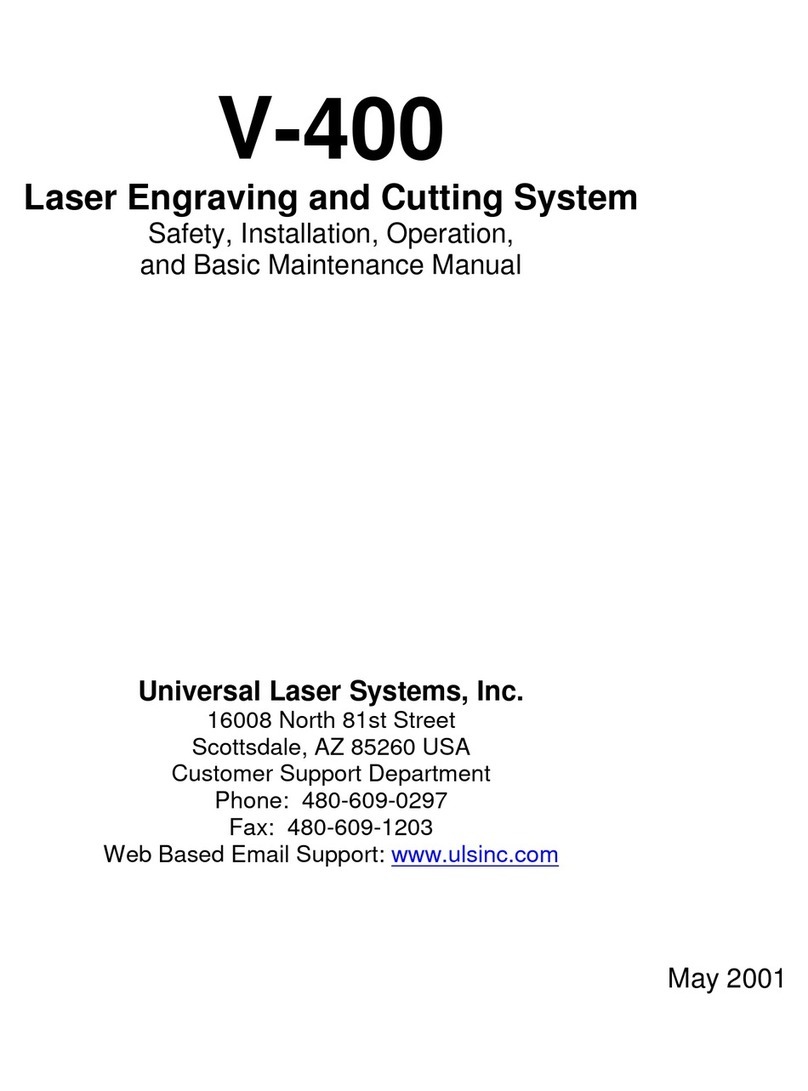
Universal Laser Systems
Universal Laser Systems V-400 Safety, installation, operation, and basic maintenance manual
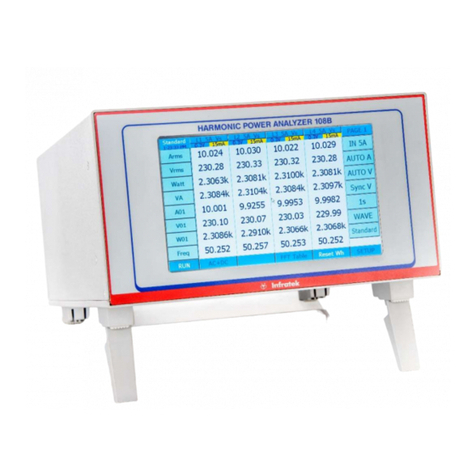
Infratek
Infratek 108B Abridged user manual
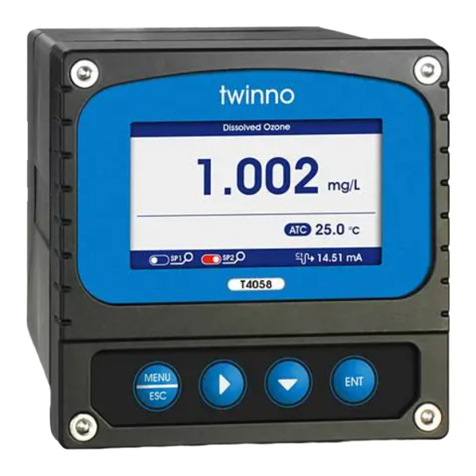
Twinno
Twinno T4058 operating manual
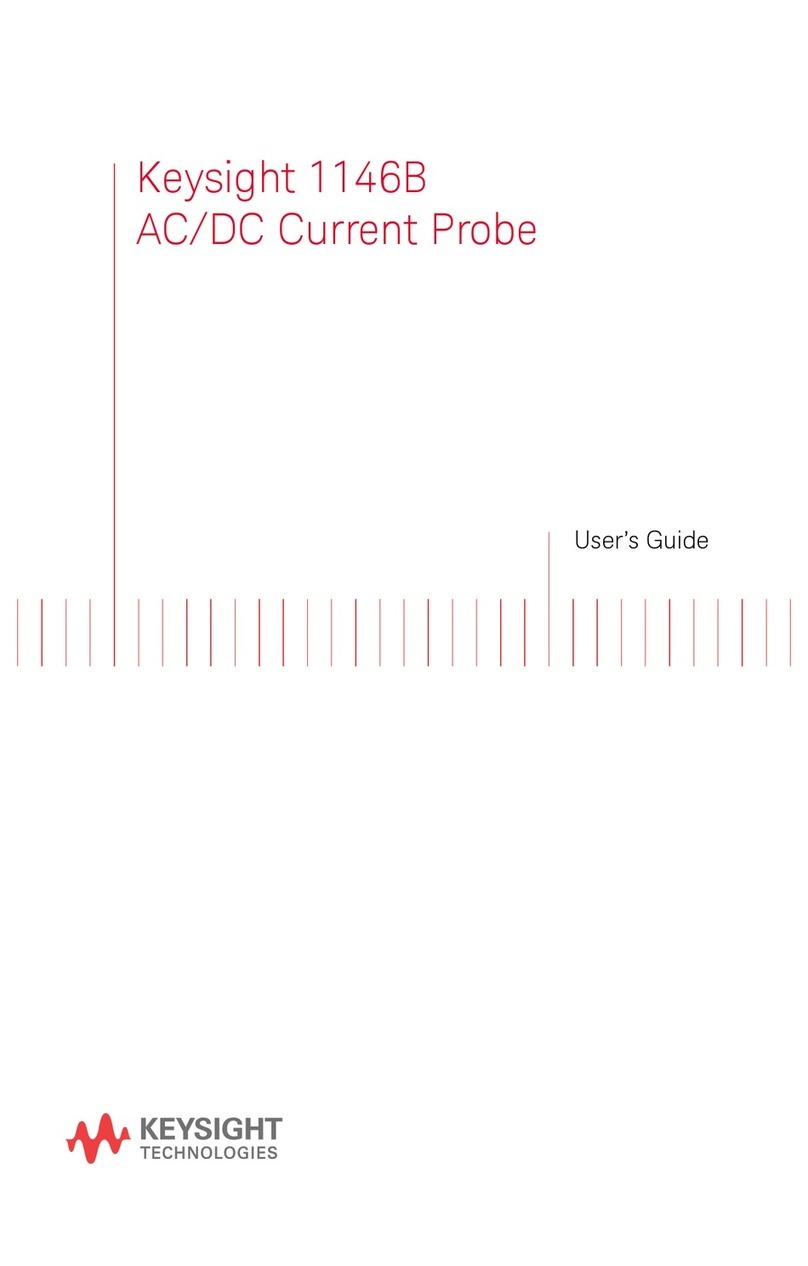
Keysight
Keysight 1146B user guide

Boonton
Boonton 4210 instruction manual
